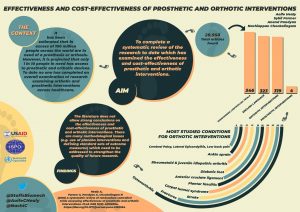An Infographic on the Effectiveness and Cost-Effectiveness of Prosthetic and Orthotic Interventions

The International Society for Prosthetics and Orthotics (ISPO) in partnership with the WHO, and funded by the United States Agency for International Development (USAID), recently published Standards for Prosthetics and Orthotics Service Provision. These Standards were developed to encourage better access to prosthetics and orthotics services.
To support the development of these Standards we were commissioned by the ISPO, in partnership with WHO and USAID, to conduct a systematic review.
What was the context to the project?
It has been estimated that in excess of 100 million people across the world are in need of a prosthesis or orthosis. However, it is projected that only 1 in 10 people in need has access to prosthetic and orthotic devices. To date no one has completed an overall examination of research examining orthotic and prosthetic interventions across healthcare.
What was the aim of the project?
The aim of this project was to complete a systematic review of the research to date which has examined the effectiveness of prosthetic and orthotic interventions.
How was information gathered?
Searches across 14 databases were used to capture all research in this area.
What were the main findings?
A large volume of research has been conducted in this area, however, there was limited high quality prospective studies. 319 English language randomised controlled trials were identified with only 4 of these examining prosthetic interventions, the rest examined orthotic interventions.
At present, for prosthetic and orthotic interventions, the scientific literature does not provide sufficient high-quality research to allow strong conclusions on their effectiveness and cost-effectiveness.
Key statistics
- The database searches resulted in a total of 28,958 articles.
- 346 randomised controlled trials were identified, of which 323 were English language. Of the 323 English language RCTs, 319 examined orthotic interventions and 4 examined prosthetic interventions.
- Orthotic interventions were categorised by the medical condition/injury with 68 categorises identified.
- The most studies conditions were:
- Osteoarthritis (30 studies)
- Fractures (26)
- Stroke (22)
- Carpal tunnel syndrome (20)
- Plantar fasciitis (18)
- Anterior cruciate ligament (post-surgery) (16)
- Diabetic foot (15)
- Rheumatoid and juvenile idiopathic arthritis (13)
- Ankle sprain (10)
- Cerebral Palsy, Lateral Epicondylitis, Low back pain (8 studies each)
What are the implications of the findings?
This review highlighted the vast range of outcome measures utilised with few studies reporting on the same outcome measures. It was also evident that studies in general did not assess if the prosthetic or orthotic interventions allowed the users to participate in the activities of daily living in which they wished to perform, which is the major consideration for the user. There are many methodological issues within this area of research which need to be addressed to strengthen the quality of future research, which would then allow conclusive decisions to be made on the effectiveness and cost-effectiveness of these interventions.
Link to full article:
Healy A, Farmer S, Pandyan A, Chockalingam N (2018) A systematic review of randomised controlled trials assessing effectiveness of prosthetic and orthotic interventions. PLoS ONE 13(3): e0192094. https://doi.org/10.1371/journal.pone.0192094
Funding:
This work was supported by the International Society for Prosthetics and Orthotics (ISPO) (Sub-grant from ISPO’s Collaborative Agreement with USAID Rehabilitation of physically disabled people in developing countries – USAID cooperative agreement DFD-A-00-08-00309-00).


